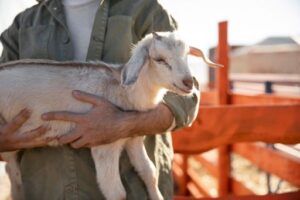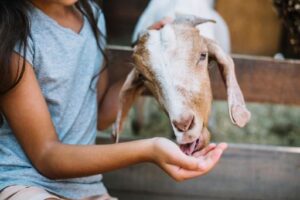Abstract
The study examined the effects of tannins on feed utilisation and lactational function in nursing Damascus goats. Thirty goats were fed a diet high in tannins from pomegranate peels for nine weeks. When tannase enzyme was added, it significantly increased diet digestibility and reduced feed consumption. Novel tannase also increased blood glucose and protein levels, increased feed efficiency and milk output, and decreased total unsaturated fatty acids (UFA) and atherogenic index.
It also decreased total unsaturated fatty acids (UFA) and increased poly UFA and total conjugated linoleic acid concentrations. The study concluded that tannases improved the way milking goats used their diets high in tannins, with novel tannase derived from Aspergillus terreus performing better than commercial tannase.
Introduction of Damascus goats
Abd El Tawab et al. (2015) investigated the impact of the naturally occurring enzyme tannase on the quality, quantity, blood chemistry, and feed utilisation of nursing Damascus goats given a diet high in tannins. Tannins, the most prevalent anti-nutritional component, can lower the nutritional content of food and have a negative impact on animal performance.
The purpose of the study was to compare how feed utilisation, blood chemistry, milk yield, and quality of lactating Damascus goats fed a tannin-rich diet containing pomegranate peel at 100 g/kg diet were affected when newly developed tannase produced from Aspergillus terreus was substituted for commercially available exogenous tannase. In addition to decreasing ruminal pH and raising daily yields of milk and solid-not-milk, the study indicated that tannase enhanced ruminal total volatile fatty acids, diet’s nutritional value, and nutrient digestibility.
Without changing the components of milk, the study discovered that tannase enhanced the digestibility of nutrients, the nutritional content of the diet, and ruminal total volatile fatty acids. It also lowered ruminal pH and raised the daily yields of milk, solid-not-fat (SNF), lactose, and ash. Tannase produced more noticeable results than polyethylene glycol.
The breed’s appearance and distinctive characteristics of Damascus goats
The majority of the long hair on the Damascus goat gives its coat a reddish brown tint. Though they are uncommon, the animal may develop white patches on its face, legs, and body (Figures 1 and 2). The occurrence of a recessive gene in the population may lead to the appearance of the highly unusual black coat colour.

The ears are long and pendulous, with a length of 27 to 32 cm. With a wither length of 78 cm, a body circumference of 97 to 99 cm, and an adult live weight of around 65±5 kg for the female and 75±5 kg for the male, this breed is fairly big. According to Hancock and Louca (1975), having horns on both sexes is linked to inter-sexuality. The head is long and has a Roman nose.
Production of tannase
At the National Research Centre in Egypt’s Dairy Science Department, A. terreus was used to create tannase. The National Research Center’s Laboratory of Plant Pathology provided the plant-origin isolate A. terreus (Egypt). An earlier description of tannase production may be found in Abd El Tawab et al. (2019). To investigate, the following species were compared: Penicillium chrysogenum, Aspergillus fumigatus, Aspergillus niger, Fusarium oxysporum, Trichoderma viride, and A. terreus.
Feed intake and digestibility
When compared to the control, the administration of tannase reduced feed consumption (P<0.05). Commercial tannase had no effect on EE or ADF digestibility when compared to the control treatment, while new tannase improved (P<0.05) nutritional digestibility. For both the novel and commercial tannases, feed intake was reduced by approximately 18.4% and 16.6%, respectively, due to tannases.
Goats’ decreased feed intake is mostly driven by the astringent and unpalatable quality of tannins, gallic acid (which is generated by tannase as a result of tannin hydrolysis), and internal malaise brought on by consuming these chemicals (Bhat et al., 2013). The results of the current investigation, which showed decreased feed consumption with increased nutritional digestibility, refute the theory.

Blood serum measurements
The amounts of glutamic-oxaloacetic transaminase (GOT), glutamic-pyruvic transaminase (GPT), triglycerides, albumin/globulin ratio, and serum globulin were not impacted by the treatments. Tannases (new and commercial).
Main Management System
A dual-purpose breed in the Middle East, the Damascus goat is an enhanced breed originally from Cyprus that combines high prolificacy with excellent milk production. To reach its full genetic potential, it needs better care and a nourishing environment. Although the breed may be handled in both small and big herd sizes, 200–300 goats is the most typical herd size.
The management and feeding methods of the Damascus goat, including its weaning and suckling schedules, energy and protein needs, and fattening procedures, have been the main subjects of research. Natural vegetation and seasonal change do not appear to have a substantial effect on the management and nutrition of the breed, according to the production method, which varies from semi-intensive to intensive.
Specifications for Reproduction of Damascus goat
The Damascus goat is regarded as a breeder of seasons. Beginning in late August and lasting until mid-December is the mating season (Mavrogenis, 1988 a). The age at first overtoestrus varies from 220 to 270 days, depending on the babies’ birth season. Depending on the kind of birth, live weights at such ages range from 42 kg to 54 kg (Mavrogenis, 1988 b).
Due to this trait, children can be bred as early as 13 to 16 months of age, and they can begin living a productive life at that age (Mavrogenis and Constantinou, 1983). After parturition, the goat resumes its reproductive activity 43±9 days later (Constantinou, 1981).Medium to high fertility (80% to 90%) is a feature shared by the majority of high-producing goat breeds. With 1.80 babies on average per doe, the breed is among the most prolific in the area.
Production Performance
A semi-intensive production technique yields reasonably good performance from the breed. High birth weights vary depending on the method of delivery and the sex, ranging from 3.5 kg to 5.5 kg (Mavrogenis, 1985; Constantinou, 1989; Mavrogenis & Papachristoforou, 2000). Many studies have been conducted on the dietary needs for growth both before and after weaning (Hadjipanayiotou and Louca, 1976; Hadjipanayiotou, 1986).
Lifespan of Damascus Goats
A Damascus goat’s lifespan is about 12 years. However, the length of time they live may differ based on their health and your level of care.
Conclusion
In lactating Damascus goats fed a diet containing tanniniferous pomegranate peel employed as a substrate for tannase synthesis, novel tannase improved nutrient digestibility, milk production, and feed efficiency compared to commercial tannase. To improve the lactation performance of Damascus goats, it is advised to supplement their food rich in tannins, which consists of pomegranate peel, with tannase derived from A. terreus at a dose of 500 IU/Kg DM.

